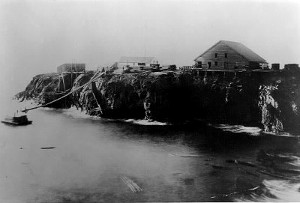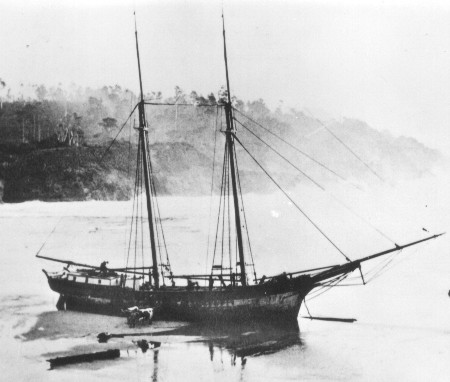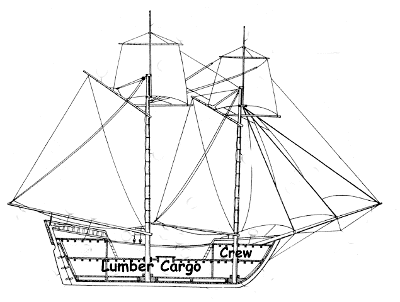|

The first sawmill in Mendocino
County, which appears as the large barn-like building in the
photograph on the left, was built on the Mendocino Headlands
for Henry Meiggs as part of the California
Lumber Manufacturing Company, incorporated June 20, 1852.
Meiggs
was a colorful San Francisco businessman, regarded by some
as an entrepreneur and others as a hustler. Meiggs sent Jerome
Ford to scout a location for a new mill, while E. C. Williams,
a veteran of the Mexican War and friend of Kit Carson, sailed
from the East Coast on the Ontario with the mill
itself, the mill machinery, and 40 mechanics and laborers
to put it all together. David Ryder, who wrote the history
of Union Lumber Company (a company that would purchase these
early Mendocino timberlands in 1906), reconstructed Ford's
journey from very brief entries in Ford's diary.
Ford
took the boat from San Francisco to Benicia, and went
from there to Napa, and then to Sonoma by stage. At
Sonoma he remained long enough to buy or hire three
saddle horses and two pack mules. Also to witness a
fight in which one of the adversaries pulled a gun and
shot half the other man's teeth out without killing
him. Ford then rode to Bodega Corners and stayed a day
or two with Captain Smith; buying eight yoke of oxen,
and hiring two men to help him with the mules and oxen.
From there the party proceeded up the Coast by slow
stages, camping wherever night overtook them. There
were no roads—only rough, narrow trails—and
they had to swim the swollen rivers. Crossing one of
them—probably the Gualala, boundary between Mendocino
and Sonoma counties—one mule drowned and the other
swam downstream, got ashore and ran away. This was a
real calamity, for, besides losing the mules, the party
lost all its provisions and blankets. Thereafter they
had only saddle blankets—"sweat cloths"
Ford calls them—to sleep under, and for thirty-six
hours they had nothing to eat but some berries they
gathered along the trail. Then they reached what Ford
referred to as "The Portuguese Ranch," near
the Navarro River, and there got their first square
meal in nearly two days, replenished their provisions,
and rested for two days. Finally after ten days of hard,
slow travel, they reached the mouth of the Big River,
which Ford alternately called the "Rio Grande"
and the "Bull Don." The former name was the
one used by the Spanish and the latter his own version
of the Indian name, "Booldam," which likewise
meant "large stream. (Ryder, 53) |
Ford finally
arrived at Big River on June 16, 1852 and E. C. Williams one
month later on July 19th. In a reminiscence that Williams,
in his 80s, wrote for the Pioneer Western Lumberman in
1912, he recalls the early days.
| The
difficulties connected with the building of the mill were
many and great. Our millwright proved wholly incompetent;
men became dissatisfied and left at a moment's warning,
and their places could only be filled by our sending to
San Francisco and bringing men overland up the Coast.
Before the mill had its roof on, the storms began; and
for years the memory of that winter came to me as a horrible
nightmare. But Spring came at last and the mill was finished,
and we began shipping its output to market at the rate
of 50,000 feet a day. (Ryder, 56) |
The 50,000 feet of lumber
that Williams refers to would fill about one railcar or two
truck and trailer loads.
With Henry Meiggs heavily
in debt, the California Lumber Manufacturing Company suspended
operations on October 10, 1854. The private banking firm of
Godeffroy and Sillem filed a lien against the mill for debts
owed, as did Jerome Ford and E.C. Williams as well. Ford,
Williams, and the banking firm would resurrect operations
in Spring 1855 with a second mill on the Big River flats.
The name of the company was the Mendocino Saw Mills. Ford
in a letter of 1865 remarks that the mill is now producing
about 15 million feet of lumber a year and bringing in $250,000
in sales
(Bear, 2) Eventually Ford and Williams
managed to pay off both Meiggs' creditors and Godeffroy and
Sillem, becoming the sole owners of the sawmills. Jerome Ford
moved to Oakland in 1872 and his son, Chester, took over the
Ford interests in the company. E.C. Williams and Chester Ford
became partners in the re-christened Mendocino Lumber Company.
In 1902 Chester Ford sold his share in the company to Captain
Asa Simpson. Williams and Simpson remained the owners of Mendocino
Lumber Company until its sale to Union Lumber Company in 1906.
David Ryder summarizes the importance of the Mendocino saw
mill in its various iterations:
| It
was lumber from the Mendocino Saw Mills (later re-named
the Mendocino Lumber Company), that helped materially
to rebuild San Francisco after its many conflagrations
in the [1850s]. It was the Mendocino Saw Mills that had
what is claimed to have been the first railroad in California—a
mile of track over which oxen pulled carloads of lumber
from the mill up to the chute on the Point. It was the
Mendocino Saw Mills that provided the first cargoes of
lumber for the little two-masted schooners which became
so much a part of the life and the history of the Mendocino
Coast. And it was the Mendocino Saw Mills that founded
the town of Mendocino and made it for years the most important
shipping center and community on the whole Mendocino Coast.
(Ryder, 57) |
Ryder's summary mentions chutes
and lumber schooners. Those, like Henry Meiggs, who were part
of the pioneer timber industry in northern California needed
a fast and efficient way to get lumber to San Francisco. There
were no accessible roads, no railroads. Transportation had
to be by sea. Meiggs built his sawmill on a promontory, called
today the Mendocino Headlands. The problem Meiggs and others
faced was, first, how to get a ship close to the coastline
and, second, how to load lumber from a bluff— 75 ft
or more high—to a ship below that at any moment could
be carried by wind or sea swells onto jagged rocks or out
to sea. This was dangerous, even life threatening, business.
There were no harbors in Mendocino County, no breakwaters,
no wharves—no such thing as "safe anchorage."
In fact, the coast at Meiggs sawmill was nothing more than
a shallow cove, often called a doghole because there
was only room, the seamen said, for a dog to turn around and
lie down.
The first part of the solution
to the problem came from the design of the ship itself. The
early Mendocino timber men used schooners that were shallow
drafted, sitting high in the water and moving more surely
over the submerged reefs. Because of the narrowness of the
hull, however, cargo space was limited.The second part of
the solution was to use an "apron chute" or adjustable
slide to lower the lumber onto the deck of a ship. This technique
is shown in the rare photograph above. Workers on the bluff
slid the lumber, piece by piece, down to deck hands who "caught,"
packed, and lashed the lumber on the schooner .Sometimes the
lumber was slid to a lighter, similar to a log raft, and then
transferred to the ship (Jackson, 141). Around 1900, wire
and steel cable was used to transfer a large load of lumber
onto a ship in one swing.
The photograph below shows
the lumber schooner, Ella Florence. The Mendocino
Saw MIlls—later the Mendocino Lumber Company—was
the owners of the Ella Florence. According to a database
of the California State Lands Commission, the Ella Florence
was stranded in 1868 off the coast of Mendocino and also
parted its moorings there in 1872. The photograph supposedly
documents that last incident. This may account for the team
of oxen, barely visible in the center of the photo. Perhaps
the oxen were there to pull some cargo off the ship resting
on the sand.

At the San Francisco Maritime
National Park, visitors will have an opportunity soon to see
one of the old lumber schooners, the C.A. Thayer.
Currently being restored, the Thayer was built in
1895 in a northern California shipyard. With a deck length
of about 156 ft and a depth of 11.38 ft, the Thayer
is typical of the small ships that carried redwood along the
northern coast to San Francisco. Her cargo capacity was 575,000
board feet, about the equivalent of ten railroad cars. Manning
the ship was generally a crew of about eight or nine men.
They lived and slept in the forward part of the bow in conditions
that would seem cramped even to an experienced submariner.

|
|
Photo Credits
First sawmill from Robert
J. Lee Collection (Ukiah).
Lumber schooner photo from
Robert J. Lee Collection (Ukiah).
Secondary Sources
Bear, Dorothy and Beth Stebbins.
Menodcino: Book Two, Gulf Press: Privately printed, 1977.
Jackson, W. Francis. Big River
Was Dammed. Mendocino, CA: FMMC Books, 1991.
Ryder, David Warren. Memories
of the Mendocino Coast, San Francisco, CA: Privately Printed,
1948.
Mendocino County Historical
Society (MCHS). Mills of Mendocino County: A Record of the
Lumber Industry (1852-1996), 1996.
Williams, Edward C. "The
First Redwood Operations in California." Pioneer Western
Lumberman 58 (July 1912): 9-13.
|